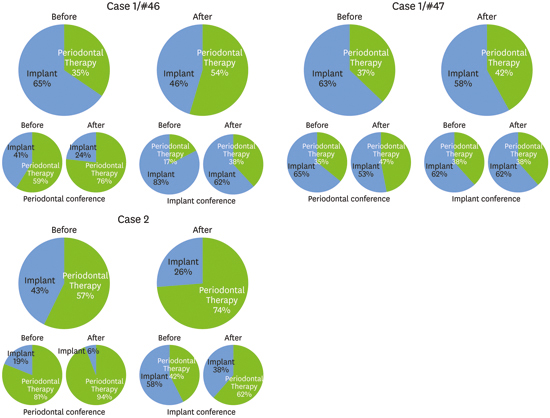INTRODUCTION
MATERIALS AND METHODS
Study design
Case modules
Case 1
 | Figure 1Clinical and radiographic photographs associated with the first and second case modules. In the first case, subgingival dental caries was observed on the mesiobuccal aspect of the first molar, and a deep periodontal pocket (10–12 mm) was detected on the mesial side of the second molar by clinical probing. Radiographic imaging revealed a radiolucent caries lesion extending to the mesial root canal of the first molar (red dotted line) and an extensive bony lesion including to the furcal (arrow) and apical areas of the second molar (white dotted line). In the second case, extensive bony destruction on the mesial side of the first molar was found clinically and radiographically (white dotted line) with involvement of the mesial furcation (arrows). |
Case 2
Design of the questionnaire
Statistical analysis
RESULTS
Characteristics of the participants
Table 1
Demographic and clinical practice-related characteristics of the participants

Preferences in decision-making about periodontally compromised teeth
Table 2
Proportions (%) of preferences regarding periodontal treatment before the debate (frequency/number of responses)

 | Figure 2Preferences of the participating dental clinicians regarding treatment decisions for each multirooted tooth in the first and second case modules. The upper two circle graphs in each panel present the proportion of preferences for periodontal therapy (to save the tooth) or placement of a dental implant (after removing the tooth), immediately before and after the debates. The lower graphs show subcategorized results from the periodontal and implant conferences. A tendency was noted among the participants in the periodontal conference to prefer periodontal therapy over dental implants. The preference for periodontal therapy increased after the debates and was also greater in the second case than in the first case. |
Effects of the debates on flexibility in decision-making
Table 3
Flexibility of decision-making in the treatment plan (%), as indicated by the proportion of participants who changed their initial decision after the debate





 PDF
PDF ePub
ePub Citation
Citation Print
Print




 XML Download
XML Download